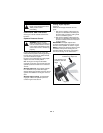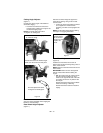GB - 6
Operation
Do not operate the engine in a confined
space where dangerous carbon monoxide
fumes can collect. Breathing exhaust fumes
can be fatal.
Edge only in daylight or in good artificial light.
Always be sure of your footing on slopes.
Walk, never run.
Use extreme caution when reversing or
pulling the edger toward you.
Make sure the blade has stopped before
crossing surfaces other than grass and when
transporting the edger to and from the area to
be edged.
Never operate the edger with defective,
missing or incorrectly fitted guards.
Do not change the engine governor settings
or overspeed the engine.
Start the engine or switch on the motor
carefully according to instructions and with
feet well away from the blade(s).
Do not tilt when starting the engine or
switching on the motor, unless the edger has
to be tilted for starting. In this case, do not tilt
it more than absolutely necessary and lift only
the part which is away from the operator.
Do not start the engine when a bystander is
standing in front of the blade(s).
Do not put hands or feet near or under
rotating parts.
Always switch off the electric motor and
disconnect from main or stop the fuel
powered engine:
• before clearing blockages;
• before checking, cleaning or working on
the blade(s);
• after striking a foreign object: inspect the
blade(s) for damage and make repairs
before restarting and operating the
edger;
• if edger starts to vibrate abnormally
(check immediately).
Stop the engine:
• whenever you leave the edger;
• before refuelling.
Reduce the throttle setting during engine run-
out and, if the engine is provided with a shut-
off valve, turn the fuel off at the conclusion of
edging.
Maintenance and storage
a. Keep all nuts, bolts and screws tight to
be sure the equipment is in safe working
conditions.
b. Never store the equipment with petrol in
the tank inside a building where fumes
may reach an open flame or spark.
c. Allow the engine to cool before storing in
any enclosure.
d. To reduce the fire hazard, keep the
engine, silencer, battery compartment,
and petrol storage area free of grass,
leaves or excessive grease.
e. Replace worn or damaged parts.
f. If the fuel tank has to be drained, do this
outdoors.
g. Do not attempt to repair the machine
unless you are competent to do so.
h. Use only manufacturer-recommended
replacement parts and accessories.


















